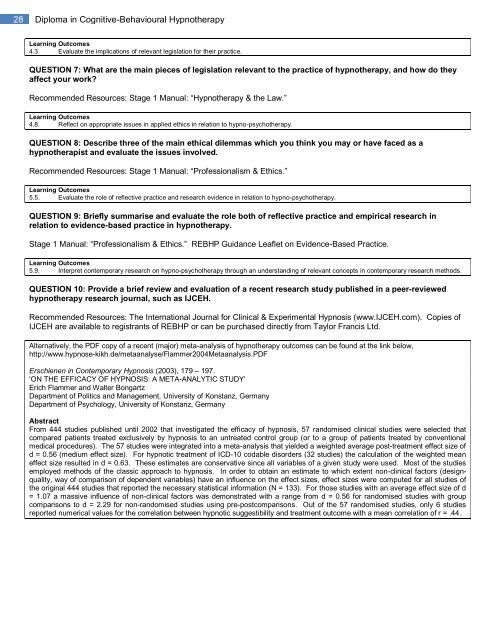Diploma in Cognitive-Behavioural Hypnotherapy - REBHP
Diploma in Cognitive-Behavioural Hypnotherapy - REBHP
Diploma in Cognitive-Behavioural Hypnotherapy - REBHP
You also want an ePaper? Increase the reach of your titles
YUMPU automatically turns print PDFs into web optimized ePapers that Google loves.
28 <strong>Diploma</strong> <strong>in</strong> <strong>Cognitive</strong>-<strong>Behavioural</strong> <strong>Hypnotherapy</strong>Learn<strong>in</strong>g Outcomes4.3. Evaluate the implications of relevant legislation for their practice.QUESTION 7: What are the ma<strong>in</strong> pieces of legislation relevant to the practice of hypnotherapy, and how do theyaffect your work?Recommended Resources: Stage 1 Manual: ―<strong>Hypnotherapy</strong> & the Law.‖Learn<strong>in</strong>g Outcomes4.8. Reflect on appropriate issues <strong>in</strong> applied ethics <strong>in</strong> relation to hypno-psychotherapy.QUESTION 8: Describe three of the ma<strong>in</strong> ethical dilemmas which you th<strong>in</strong>k you may or have faced as ahypnotherapist and evaluate the issues <strong>in</strong>volved.Recommended Resources: Stage 1 Manual: ―Professionalism & Ethics.‖Learn<strong>in</strong>g Outcomes5.5. Evaluate the role of reflective practice and research evidence <strong>in</strong> relation to hypno-psychotherapy.QUESTION 9: Briefly summarise and evaluate the role both of reflective practice and empirical research <strong>in</strong>relation to evidence-based practice <strong>in</strong> hypnotherapy.Stage 1 Manual: ―Professionalism & Ethics.‖ <strong>REBHP</strong> Guidance Leaflet on Evidence-Based Practice.Learn<strong>in</strong>g Outcomes5.9. Interpret contemporary research on hypno-psychotherapy through an understand<strong>in</strong>g of relevant concepts <strong>in</strong> contemporary research methods.QUESTION 10: Provide a brief review and evaluation of a recent research study published <strong>in</strong> a peer-reviewedhypnotherapy research journal, such as IJCEH.Recommended Resources: The International Journal for Cl<strong>in</strong>ical & Experimental Hypnosis (www.IJCEH.com). Copies ofIJCEH are available to registrants of <strong>REBHP</strong> or can be purchased directly from Taylor Francis Ltd.Alternatively, the PDF copy of a recent (major) meta-analysis of hypnotherapy outcomes can be found at the l<strong>in</strong>k below,http://www.hypnose-kikh.de/metaanalyse/Flammer2004Metaanalysis.PDFErschienen <strong>in</strong> Contemporary Hypnosis (2003), 179 – 197.‗ON THE EFFICACY OF HYPNOSIS: A META-ANALYTIC STUDY‘Erich Flammer and Walter BongartzDepartment of Politics and Management, University of Konstanz, GermanyDepartment of Psychology, University of Konstanz, GermanyAbstractFrom 444 studies published until 2002 that <strong>in</strong>vestigated the efficacy of hypnosis, 57 randomised cl<strong>in</strong>ical studies were selected thatcompared patients treated exclusively by hypnosis to an untreated control group (or to a group of patients treated by conventionalmedical procedures). The 57 studies were <strong>in</strong>tegrated <strong>in</strong>to a meta-analysis that yielded a weighted average post-treatment effect size ofd = 0.56 (medium effect size). For hypnotic treatment of ICD-10 codable disorders (32 studies) the calculation of the weighted meaneffect size resulted <strong>in</strong> d = 0.63. These estimates are conservative s<strong>in</strong>ce all variables of a given study were used. Most of the studiesemployed methods of the classic approach to hypnosis. In order to obta<strong>in</strong> an estimate to which extent non-cl<strong>in</strong>ical factors (designquality,way of comparison of dependent variables) have an <strong>in</strong>fluence on the effect sizes, effect sizes were computed for all studies ofthe orig<strong>in</strong>al 444 studies that reported the necessary statistical <strong>in</strong>formation (N = 133). For those studies with an average effect size of d= 1.07 a massive <strong>in</strong>fluence of non-cl<strong>in</strong>ical factors was demonstrated with a range from d = 0.56 for randomised studies with groupcomparisons to d = 2.29 for non-randomised studies us<strong>in</strong>g pre-postcomparisons. Out of the 57 randomised studies, only 6 studiesreported numerical values for the correlation between hypnotic suggestibility and treatment outcome with a mean correlation of r = .44.


